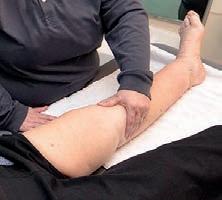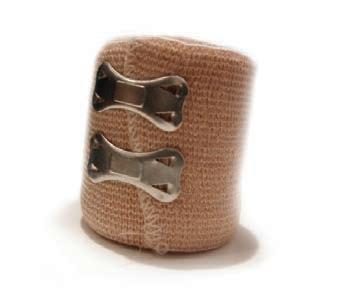
4 minute read
Lymphedema in gynecological cancer
Considerations for an underrepresented population of lymphedema patients
Risk factors, treatment, risk reduction and more…
By Shirin Shallwani
the absence of a standardized method of evaluation for lower body lymphedema and the general lack of awareness among both health professionals and patients regarding lymphedema3. These challenges result in inaccurate or delayed diagnoses and, consequently, late referrals to appropriate specialist services for management.
Incidence and risk factors
Due to different evaluation methods utilized, it is difficult to determine the exact incidence of lymphedema after gynecological cancer and reported figures range widely from 0 to over 70%3,4. Large studies in this population have recently estimated more precise incidence rates of 25% to 45%4,6,7. By comparison, in women with breast cancer, the pooled incidence of lymphedema is estimated to be around 20%5. In two studies, about half of the women with gynecological cancer reporting symptoms of leg swelling had a confirmed clinical diagnosis of lymphedema8,9. These findings suggest a high prevalence of women living with this chronic condition after gyncecological cancer, including may cases of undiagnosed lymphedema.
Several risk factors for leg lymphedema after gynecological cancer have been identified. In a meta-analysis, the highest rates of lymphedema were found for vulvar cancer and cervical cancer diagnoses4

Shirin Shallwani is a physiotherapist and certified lymphedema therapist specialized in cancer rehabilitation. She is currently pursuing her doctoral studies at the University of Ottawa School of Rehabilitation Sciences and is involved with clinical research at the McGill University Health Centre Lymphedema Program.
Additional risk factors for lymphedema include surgical lymph node dissection, radiation therapy and obesity3,4,9
Risk factors for lymphedema after gynecological cancer n Diagnosis of vulvar cancer n Surgical lymph node dissection n Radiation therapy n Obesity (BMI >35)
Signs and symptoms/impact
Most cases of lower limb lymphedema develop within the first year following diagnosis of gynecological cancer3,9. Symptoms experienced by patients may include heaviness, tightness, aching and/or pain in the legs9. The swelling usually commences proximally (thigh area), often affects both legs and may be associated with symptoms of numbness and weakness3
An important complication of lymphatic injury is an increased risk of developing subcutaneous bacterial infections (cellulitis).

The effects of lymphedema in women with gynecological cancer are significant and concerning. Reported issues include challenges with daily physical activities (e.g. walking, housework, exercise), concerns regarding appearance and self-image, and psychosocial difficulties (e.g. depression, anxiety, social isolation)3,8-10
Financial concerns, due to the additional costs associated with lymphedema management as well as difficulty with employment, have also been reported in women with gynecological cancer-related lymphedema3. In non-Canadian studies, the annual costs of traditionally managing moderate or severe breast cancer-related lymphedema are estimated to range from $1000 to over $300011,12. The cost of managing leg lymphedema related to gynecological cancer is likely higher than these figures (e.g. due to more extensive and sometimes complex compression systems required). These issues highlight the important impact of lymphedema on patients as well as on the health care system.
Assessment of lymphedema
The assessment and identification of lymphedema after gynecological cancer is challenging for several reasons3. There is no standard method to assess lower body lymphedema, as its signs and symptoms may be subtle and frequently unrecognized. Moreover, lower body lymphedema often affects both legs and the absence of an unaffected leg for comparison makes it difficult to note changes in tissue texture and leg volume. In addition, the presence of postoperative swelling, common changes in body weight during and after cancer treatment, and the shortage of specific patient questionnaires contribute to the complexities of evaluating lymphedema in this population. The method of assessment recommended in the literature is a physical examination by a certified lymphedema specialist3. This may consist of a medical history, symptom assessment, skin evaluation and circumferential/volume measurements. The 20-item Gynecologic Cancer Lymphedema Questionnaire (GCLQ) has been designed specifically for gynecological cancer-related lymphedema3,13 This questionnaire may help provide a better understanding of lymphedema-related concerns experienced by patients and may be useful in identifying lymphedema in undiagnosed patients with gynecological cancer13

Treatment of lymphedema
Currently, the standard treatment of lymphedema after gynecological cancer remains traditional complex decongestive therapy, consisting of skin care, compression therapy (i.e. compression stockings and/or multi-layer bandaging), decongestive exercise and manual lymph drainage. This multi-modal approach has been found to be effective in several lymphedema populations, but has not been extensively studied in women with gynecological cancer14. Alternative compression therapies, such as padded bandage liners, adjustable compression systems with Velcro straps or single-use cohesive bandaging systems, may also be helpful in certain cases (e.g. for nighttime use, in patients with neurological
Lymphedema management

New streamlined lymphedema training in 13 classroom days coming soon.
~ Evidence-based
~ Easy learning modules with small class sizes
~ Interactive, live classroom instruction with physicians
~ Learn precise manual skills with expert, accredited instructors

~ ISO 29990: 2010 certified training
~ CE credit available exercise, including weight-lifting and aqua lymphatic therapy, have been briefly explored and demonstrate potential benefits in patients with lower limb lymphedema15,16. However, caution must be used with respect to skin care during exercise to minimize the risk of cellulitis infections15

Surgical approaches, including microsurgical techniques to improve lymph flow (e.g. grafts, transplants) or ablative methods to remove fatty tissue (e.g. liposuction), may be useful in the management of lymphedema but are typically reserved to patients meeting precise eligibility criteria3. Complications of surgery include infections, pain, wound healing issues and skin necrosis. Moreover, post-operative care after these surgeries often requires continued compression therapies. Currently there are no standard guidelines on the indications of surgical methods for the management of gynecological cancer-related lymphedema.

Lymphedema risk reduction
Due to the challenges of treating lymphedema, more attention is needed on risk reduction strategies, particularly in the gynecological cancer population3. To date, most research in this area has focused on the use of different surgical methods, such as tissue sealants, laparoscopic or robotassisted techniques, and sentinel lymph node biopsy, to minimize the potential for causing lymphedema3,17. Additional strategies, such as early compression therapy and exercise, have only been briefly explored and further research in these areas is needed18 Current recommendations suggest patient education, post-operative surveillance and early referral to specialists to reduce the risk of lymphedema development and progression in women with gynecological cancer3,4
Lymphedema is an important, prevalent, and often unrecognized issue in women with gynecological cancer that is associated with long-term physical and psychosocial challenges. Further efforts are urgently needed to promote awareness about lymphedema, to develop risk reduction strategies, to improve assessment methods for timely and accurate diagnoses, and to effectively treat lymphedema in the gynecological cancer population. LP
A full set of references can be found at www.lymphedemapathways.ca

